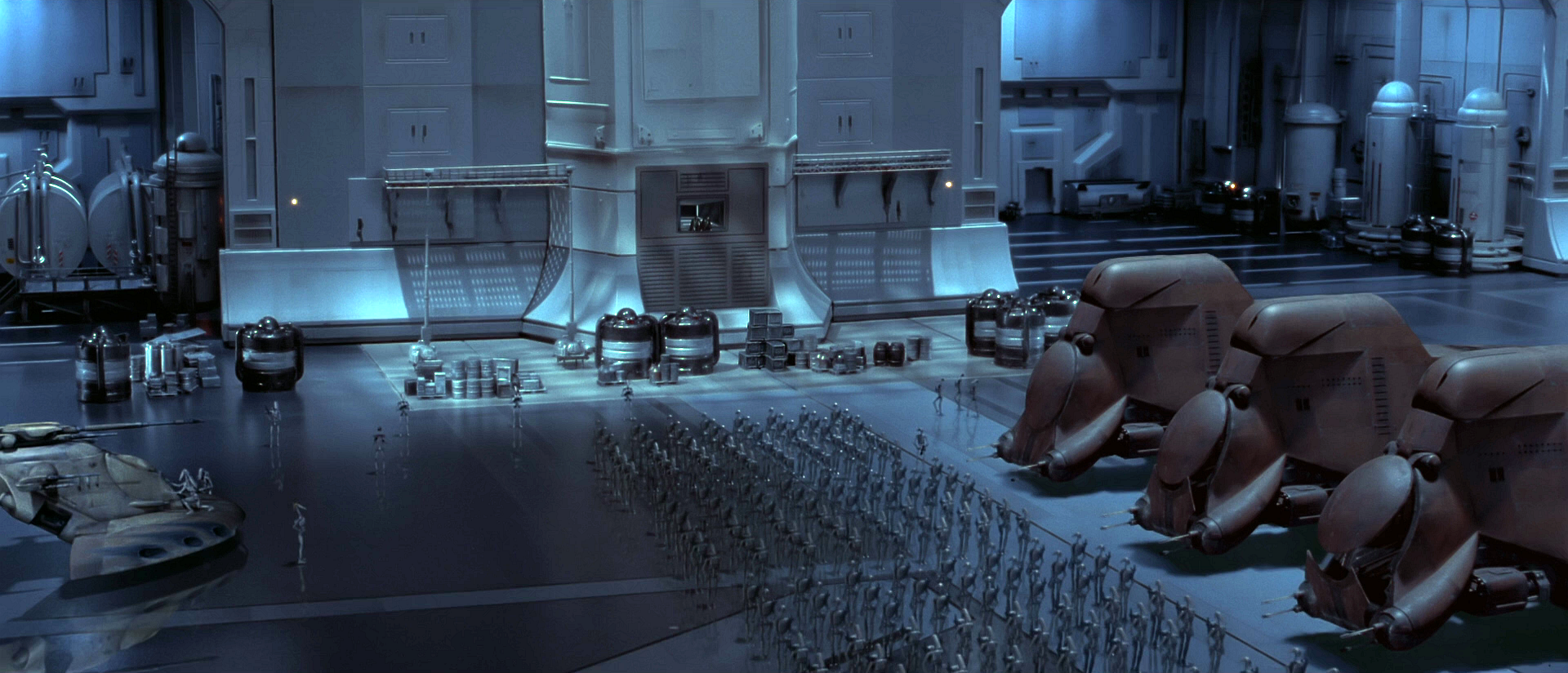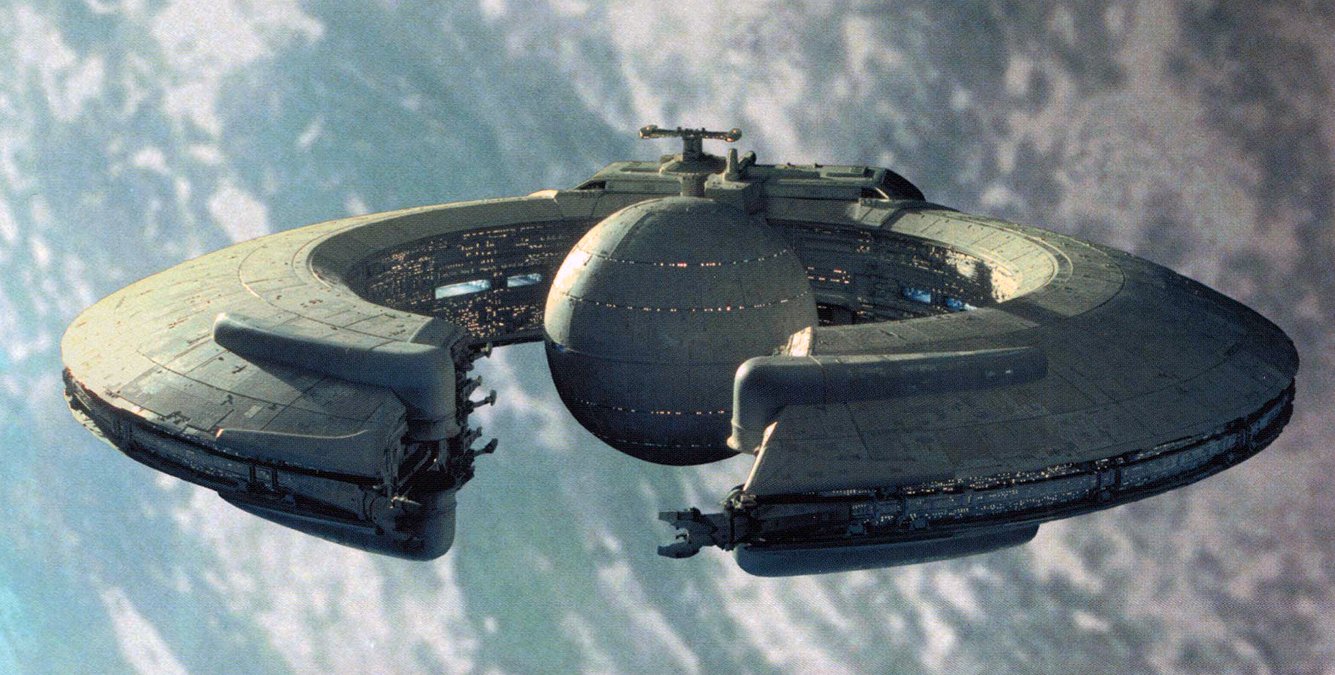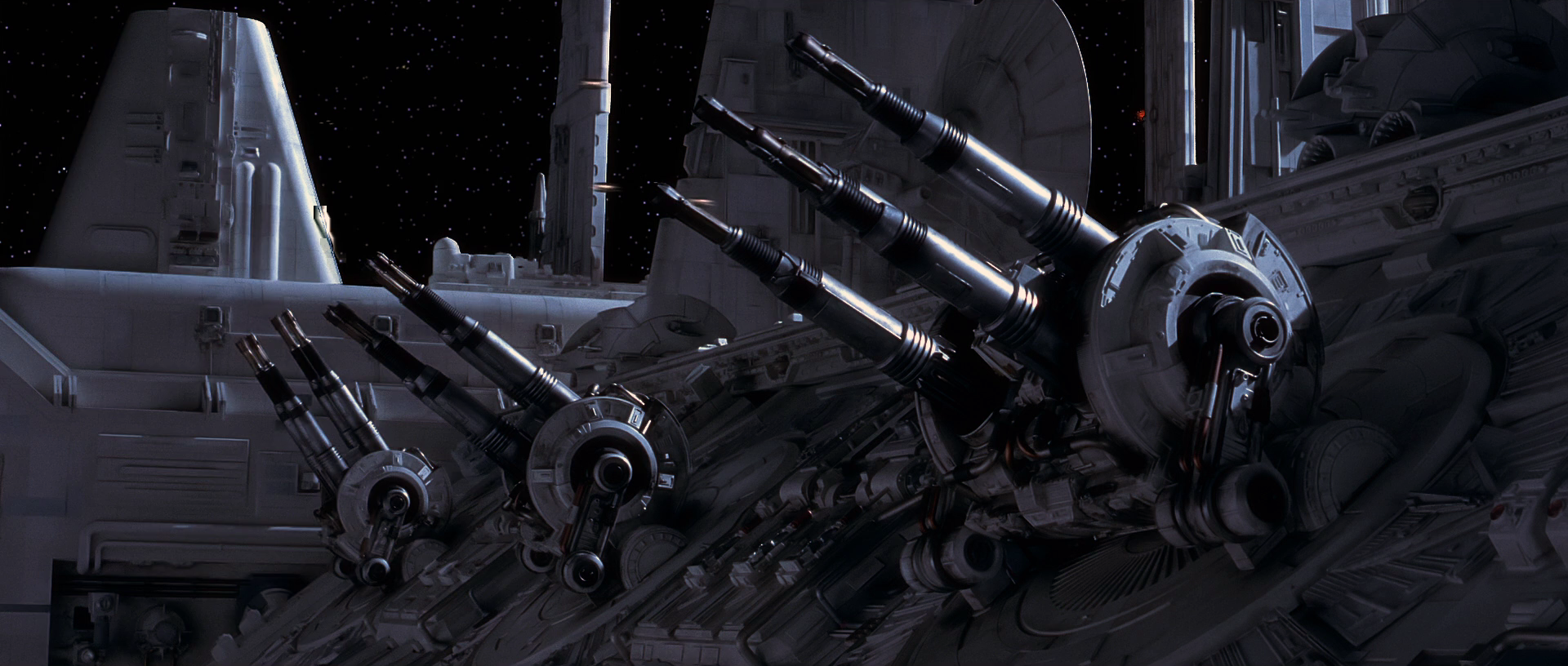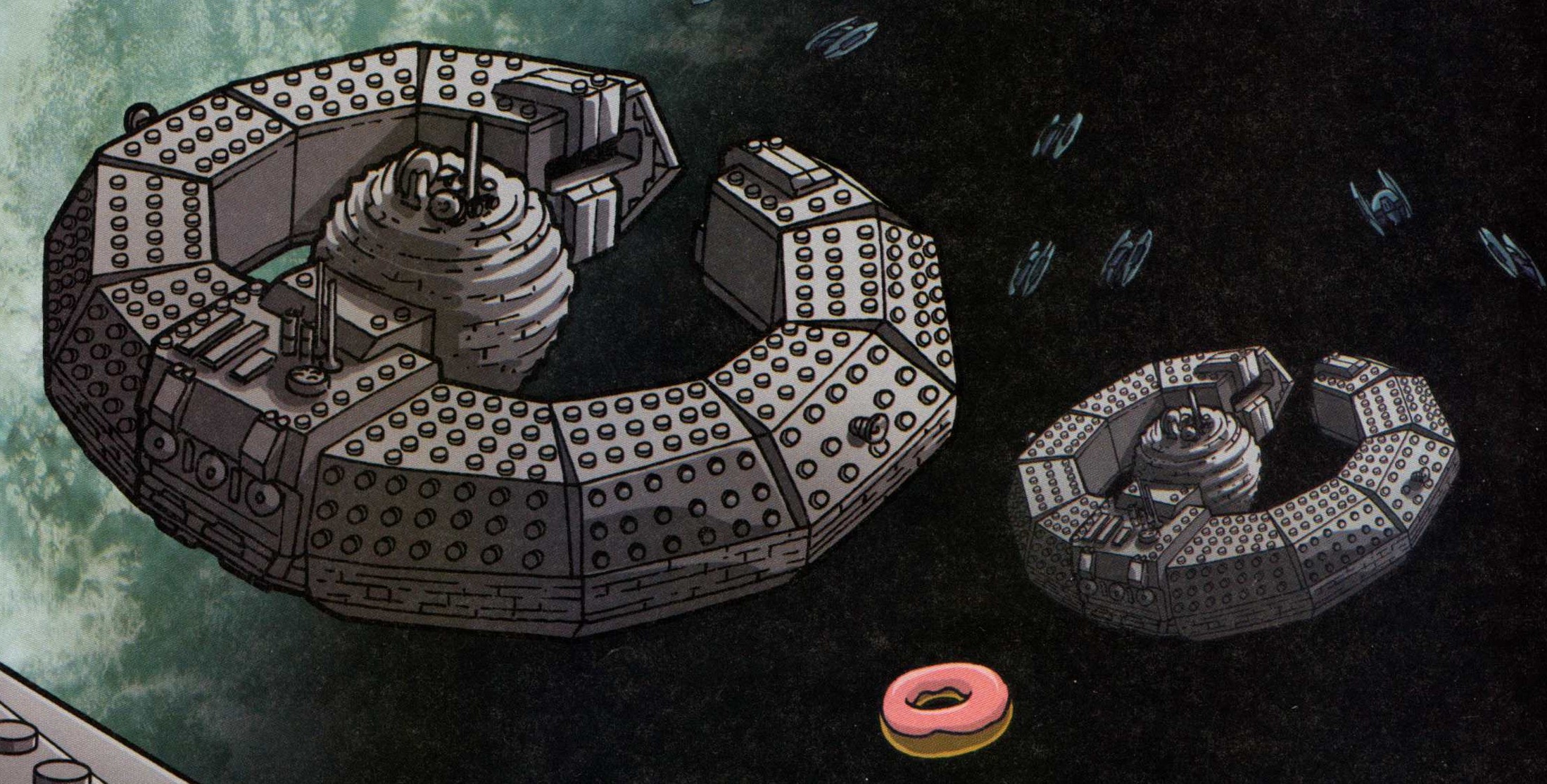
A hangar bay with Multi-Troop Transports
At over three kilometers in diameter, the enormous vessel resembled a donut-shape that was missing a section of its circumference, and it had a central sphere that contained the ship's bridge and reactor assemblies. The front void of the craft held two behemoth docking bays on either side, which were lined with forward docking claws. These gigantic cargo vessels had been built for many years by the Trade Federation to haul cargo between planets and were an important asset to their enterprise.
Housed in the stern of the main body were the main reactors, each connected to one of the three main engines, as well as to secondary engines and each other. The central sphere housed its own reactor/power generator assemblies.
Lining the equatorial bands in batteries of three, were quad turbolaser cannons capable of rotating inwards when not in use. Their limited coverage of the hull made the early battleship models vulnerable and made them rely more on the massive number of starfighters carried to defend the ships against enemy starfighters. This was, however, rectified with later ships whose armor and shields proved too strong for starfighter firepower, the fact becoming quickly apparent at the Battle of Naboo. The pre–Clone Wars models of the battleships did have major defense flaws, as Anakin Skywalker was able to fly his starfighter into the hangar of a Droid Control Ship and destroy the starboard main reactor by accident. The resulting explosion destroyed the battleship and ensured a Naboo victory.
Lucrehulk-class battleships that fought in the Clone Wars had less trouble with weak spots, as they were augmented with gun batteries and much stronger shielding. Batteries of long guns and heavy guns complemented the additional quad turbolaser batteries added to the Lucrehulk superstructure when the war erupted.
Each ship was also now so powerful due to the increased amount of power devoted to offensive and defensive systems that a whole flotilla of Republic Star Destroyers was needed just to bring down a Lucrehulks shields. The Clone Wars refitted models were true battleships and were among the most powerful ships in the Confederate Navy. Due to their firepower and strong shielding and armor, and large starfighter complements, these battleships were often used as command ships and as blockade vessels.
When the Trade Federation began creating its military, the Executive Board realized the need for large cruisers to transport their weapons across the galaxy, battleships to defend against starfighter attacks, and flagships for controlling their vast legions of battle droids. Reluctant to spend the credits necessary to construct and purchase a fleet of military vessels, the Trade Federation began modifying a portion of its many thousands of Lucrehulk-class freighters into warships. Their early navy had about 10% of all Lucrehulks converted to battleships and by the battle of Naboo, it was estimated that 35% of the class had undergone refitting.

A blockade battleship over Naboo
The Trade Federation used a substantial fleet of Lucrehulk-class battleships to enforce the invasion of Naboo, led by the flagship Saak'ak. The most important vessel in the Trade Federation's blockade was the Lucrehulk-class Droid Control Ship Vuutun Palaa. When the rest of the blockade dispersed after Naboo was successfully occupied, the Neimoidians left the Droid Control Ship in orbit to coordinate their droid forces. The Control Ship was later destroyed by the young Anakin Skywalker, resulting in the deactivation of the Droid Army.
After the Invasion of Naboo, the Republic ordered the Trade Federation to disband its military forces. The crafty Trade Federation pretended to comply with this command by apparently disassembling most of its battleships, only to transform their centrispheres into detachable core ships capable of carrying supplies as well as increasing the battleship's armaments.
In 27 BBY, two of these vessels were used to try to destroy Outbound Flight. The Chiss Commander Thrawn destroyed one of the Lucrehulks, allowing the other to surrender.

Three quad turbolaser cannons on a Trade Federation battleship
Lucrehulk-class core ships were used during the Battle of Geonosis, where they carried legions of battle droids. In retreat, the Core Ships were found to be able to reattach themselves to the outer ring. These vessels saw continued use during the devastating Clone Wars, transporting military equipment and troops to countless worlds, and engaging Republic fleets in combat.
During the wars, the Lucrehulk-class battleship received a massive upgrade in terms of firepower, with the addition of hundreds of long guns, quad guns, and heavy guns dotting the surface of both the core ship and the surrounding cargo arms. They, along with the other capital ships of the Confederate Navy, also proudly wore the colors and insignia of the Confederacy. A few dozen participated in the attack on Coruscant towards the end of the war.
During the Imperial Period, some militarized Lucrehulks remained in operation, fighting on the side of Separatist holdouts or early Rebel Alliance units. A few battleships kept in Imperial surplus stock were also sold to the Corporate Sector and to wealthy merchants. Other ships were dismantled and sent to garbage dumps like Raxus Prime. Several captured Lucrehulks were pressed into service in the Imperial Navy and used to host flight schools for military fighter pilots. Several Lucrehulks, belonging to an unknown party, were also involved in a skirmish with Rebel forces.
One of several Alliance Lucrehulks, the Fortressa served as a starfighter carrier, carrying a complement of hundreds of T-65 X-wing starfighters. In 0 BBY, it participated in an assault on the first Death Star and was destroyed by the battle station's superlaser. In 36 ABY, dozens of Lucrehulk-series freighters were appropriated by forces allied with The Colony and used as carriers for Dartship swarms during the Swarm War.

LEGO battleships, starfighters and a donut floating above Naboo in LEGO Star Wars: Darth Maul's Mission.
Lucrehulk-class battleships first appeared in 1999 with the release of Star Wars: Episode I The Phantom Menace and its tie-ins. It has since appeared in every movie of the prequel trilogy.
George Lucas wanted the battleship to have a retro-saucer look, but felt it needed a distinct sense of front and rear. Doug Chiang achieved this in early concept art by adding the antennae and docking section to one side, and a set of engines to the other. Lucas himself added the "bridge ball" to the center for the finished design.
Battleships have appeared in LEGO form in the 2005 video game LEGO Star Wars: The Video Game and in the 2012 young readers book LEGO Star Wars: Darth Maul's Mission.
- LEGO Star Wars: The Video Game
- LEGO Star Wars: The Complete Saga
- LEGO Star Wars: Darth Maul's Mission
- LEGO Star Wars: Revenge of the Brick